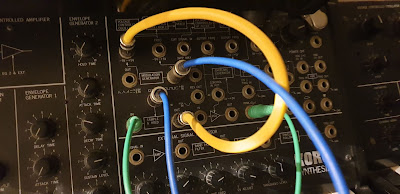A classic drum, but programming her can be challenging if you're new to it.
Here's a in depth guide on how to program drum patterns on the
TR- 909.
Check out the quick start guide here:
+
Roland TR 909 Programming Tutorial - getting started
When you first turn on your 909 you will enter TRACK MODE
The drum will look something like this:
You won't be able to run the sequencer, but if you just hit any of the 1-16 buttons, you will hear the sounds. ..... Enjoy !!!!
Like the Roland Tr 606 & TB303, the 909 drum memory can be divided into Tracks & Patterns.
The 3 pattern groups can store 16 patterns each (16x3=48).
There are 2 banks of these groups (2x48=96)
So it can store up to 98 patterns.
These patterns can be arranged into 8 tracks. (2 banks of 4 track groups).
---------------------------------------------------------------------------------------------
1. Clearing Patterns
(Pattern Write Mode)
2. Step Recording
(Pattern Write Mode)
3. Real time (Tap) recording
(Pattern Write Mode)
4. Shuffle / Swing
5. Sync Mode
6. Scale
7. Track Play mode
8. Track Write mode (deleting tracks)
9. MIDI
1. Clearing Patterns.
It always good to start with a blank slate. If you have just purchased a 909 (congratulations)
... it will probably have some old patterns already programmed into the memory.
a) Put the TR-909 into Pattern Write Mode.
Press Shift + one of the Pattern Play buttons.
b) Press Shift button + press the Step Tempo button.
c) Hold the Clear button + press 1-16 on the main buttons to select the pattern to clear.
If you now press play (on the external sequencer or the internal 909's sequencer), you won't hear
anything, though you will see the sequencer lights running across the 16 steps.
2. Step Recording
There are two types of recording:
+ Step Recording
+ Real time (Tap) recording
Step, is I think the easier of the two.
a) Put the TR-909 into Pattern Write Mode
* Hold Shift & one of the Pattern Play buttons.
b) Select your instrument by holding down the Instrument Select button
and pressing one of the 1- 16 buttons.
c) Press Start ( the drum will run) Now add your beats by pressing buttons 1-16.
d) repeat this till you have picked your voices.
You accent the drums by hitting the buttons twice.
3. Real time (Tap) recording
You can combine the two methods of programming.
I like to start programming in Step mode then add extras using TAP.
a) press Shift + Tap (in the Pattern Write Mode section).
b) To hear the metronome press the "Guide button" and you will hear the click when Start is pressed.
c) Use buttons 1-16 to program your new rhythm or embellish your already existing
pattern.
Note:
The 909 will quantise your beats.
Pressing the 1-16 buttons more than once will make them sound louder.
4. Shuffle/Flam
To adjust the shuffle, you press Shuffle/flam and one of the buttons 1 to 7.
You can back it off a bit by going back to 4 or 5...
Flam uses the buttons 9 to 16.
Flam is like a ratchet double hit
5. Sync Mode
a. Shift + Tempo Mode (Din sync, Midi, or Internal)
You need to tap the Tempo mode button till the display shows either
a "0" in the left (Din), a "0" in the middle (MIDI) or the BPM on the right (eg 120)
6. Scale
You can change the time signatures, but hitting scale.
Scale changes the sub division of the pattern.
7. Track Play
a) press Shift + Bank (I or II)
b) Now, select a track to play
Press Track Play (1,2,3,4)
c) Press start (to play the existing track)
d) Press Stop
8. Track Write
To Delete an existing track
a) press Shift + Bank (I or II)
b) Now, select a track to edit
Press Shift + Track Write (1,2,3,4)
c) to delete a track press
Shift + button 1-16
While still holding shift press Enter.
While still holding shift Press DEL (under button 13)
While still holding shift press LAST MEAS (last measure)
While still holding shift press Enter
Hit START to check that the track is now empty.
To Write a new track
(assuming the track is empty, otherwise delete as above)
a) press Shift + Bank (I or II)
b) Now, select a track to edit
Press Shift + Track Write (1,2,3,4)
c) hit START
d) press pattern group (1,2,or 3) + pattern number 1-16
e) press Enter
f) repeat steps (d) & (e) until you have finished picking the patterns.
g) press STOP (that's it)



 ..
..















































